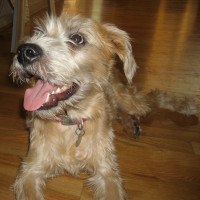Appearance of the Soft Coated Woxer
|
| The Soft Coated Woxer often adopts the square shape of its Boxer parent, but this is often combined with the soft coat of the soft-coated Irish Soft Coated Wheaten Terrier parent. The result is a solid, attractive dog with a soft, slightly curly coat. They tend to have the longer muzzle of the Irish Soft Coated Wheaten Terrier rather than the slightly short, pushed-out face of the Boxer, which means they have fewer breathing problems. Its strong, muscular body and long legs give it a powerful body that is softened by its shaggy coat. Often, the legs are covered with soft, wavy fur that covers them all the way down to their rounded, well-padded feet. The paws, chest and perimeter of the face may be covered with feathers, giving them a teddy-bear appearance. The thick neck supports the rectangular head and relatively short muzzle. The nose is black and the eyes are almond-shaped and reddish-brown to darker brown. Ears can vary from alert and erect to soft and supple, depending on the genetic influence of the parents. The tail is often docked, but can be left natural and may also include a few feathers. Soft, silky and yet powerfully built, Soft Coated Woxers are pleasing to the eye and make excellent companions and watchdogs. |
Temperament of the Soft Coated Woxer
|
| Playful, mischievous, eternal pups it seems, but the Soft Coated Woxer has a serious side. They can be quite reserved when meeting new people and dogs, and can adopt a slightly aggressive attitude if nervous or insecure. But they're never vicious, far from it. On the contrary, this is a dog with a cheerful outlook on life, perhaps a little stubborn at times, but quite comical at others. Living with a Soft Coated Woxer is never boring. He can even have fun on his own, playing with his dog toys and chasing birds in the yard. But he'll never be far from you when you're at home. The Soft Coated Woxer is a popular dog, needing human interaction and living for you. Loyal and devoted, this dog is a true companion. And yet, like all companions, they can have their little idiosyncrasies. If he's bored, he may gnaw on anything he finds, or dig holes so that your yard looks like a lunar landing site, potholes in pieces. Keeping them entertained is one way to avoid this problem, and training and exercising their active minds is another. If you don't have time to devote to this dog, it's likely to develop behavioral problems. They need company, they live for you. So think twice before buying one of these adorable teddy bears. The Soft Coated Woxer is great with children and gets on well with other pets, provided they're raised together. However, he has Terrier origins, so the temptation to chase little furry creatures is very strong. Always keep him on a leash when walking, as he'll wander off if you don't restrain him. Solid, strong and comical, Soft Coated Woxers seem to have retained their puppy-like enthusiasm and engaging behavior, making them ideal family dogs. |
Needs and activities of the Soft Coated Woxer
|
| Although the Soft Coated Woxer loves to play and will follow you around the house all day, it will need to get out for a good walk to expend some of its energy. Walks are ideal for your dog to practice his socialization skills, which all dogs need to learn. Training is also beneficial for dogs, as it tests their intelligence and provides essential mental stimulation. With the Soft Coated Woxer, it's advisable to keep training fun, and to offer rewards and praise rather than harsh commands. Most dogs will switch off if training isn't fun or if brutal methods are used, so use praise and petting to get the performance you want from your dog. These lively dogs will love to play with a selection of dog toys, and can be quite comical to watch. With a Soft Coated Woxer in the family, life will never be dull. They're exuberant and simply love life. Adaptable to most climates and housing, they're perfect with a garden to explore, but also adapt to apartment living, provided they can take a walk or two a day. |
Maintenance of the Soft Coated Woxer
|
| Depending on your dog's inherited coat, maintenance can be low or high. If your Soft Coated Woxer has the coat of a soft-coated Irish Soft Coated Wheaten Terrier, it will need to be combed at least twice a day, as this beautiful coat has a price: your time. It can tangle easily, and brushing is not always recommended as it can make the coat fluffy. It's best to comb the coat for best results and to preserve its texture. This type of coat also requires monthly bathing with a natural dog soap, rinsing and careful combing. But the coat can be a combination of the short hairs of the Boxer and the longer hairs of the Irish Soft Coated Wheaten Terrier, which requires less maintenance. Ears and eyes are vulnerable areas. So make sure your dog has no wounds or infections in these areas. Like most dogs, they need their teeth brushed regularly to keep their breath fresh. There are products specially designed for dogs, which are better suited to their health. Depending on your dog's coat, it may need clipping every two months to keep it in shape. Finish the grooming by trimming the nails, if necessary, and your dog's day is over. |









 English (United Kingdom)
English (United Kingdom)